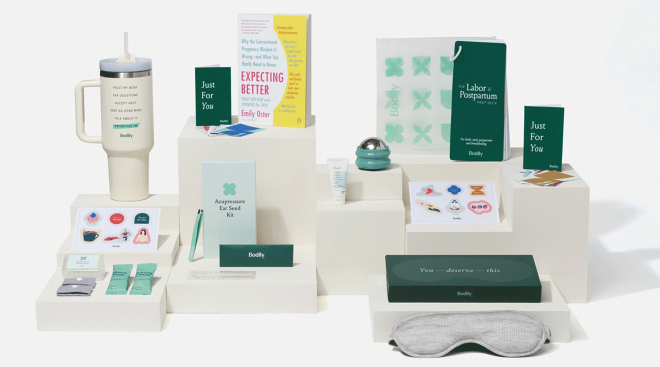Why a Postpartum Plan Is Just as Important as a Birth Plan
Bringing baby home from the hospital calls for more than a decked-out nursery or piles of diapers and onesies. Let’s just say, the first few weeks of parenthood are going to be amazing and exhausting—and your physical and mental fortitude will be put to the test. But with such a strong emphasis put on labor and delivery prep, you may have overlooked the concept of creating a postpartum plan. It’s not required, but your “new normal” will feel much more manageable with a strategy in place and support lined up. So what should your postpartum plan entail? Read on for expert advice and practical tips to help you design a blueprint that’ll get you through these rollercoaster days and nights.
For the past nine+ months, you’ve tracked your symptoms, diligently taken your vitamins and showed up for every prenatal appointment. Your hospital bag is packed, your childbirth class is completed and your birth plan is printed in duplicate—you’re ready for labor and delivery. But are you adequately prepared for everything that comes afterwards? The postpartum period is exhausting on so many levels, so setting up a basic framework with rules, roles and expectations can help with the often turbulent transition into parenthood.
Getting your ducks in a row before baby comes is key. It can be tough to ask for help in the moment—especially for new moms who struggle with guilt and feel the pressure to do it all, says Michelle Risser, LISW-S, a social worker and counselor with a focus on maternal and perinatal mental health at Choosing Therapy, a video therapy platform. “A postpartum plan lays out the new parents’ wishes, requests, boundaries and support system after the baby arrives.”
Your postpartum plan can be as broad or as detailed as you want. For starters, consider including a timeline if you’re planning on returning to work, childcare options to look into, meal-planning resources and products you’ll need for recovery (you know, the not-so-cute items you didn’t put on your registry—things like a peri bottle and hemorrhoid wipes).
Adding a list of vetted contacts you may need, like a lactation consultant and a perinatal psychologist, can help to make challenges feel less intimidating if and when they arise.
Keep in mind that, much like a birth plan, a postpartum plan can go awry. An unplanned or emergency c-section or a NICU stay can sway expectations of homecoming, so you’ll want to think about a Plan B (and maybe even a Plan C). Either way, there are a few things to consider as you’re getting ready for the fourth trimester. Here are some of the biggest pain points to work through.
Figure out responsibilities
Even the most level-headed people can be caught off guard by all the changes that come with baby’s arrival. “Many new mothers expect their partner to do 50 percent of the baby care—diaper changing, soothing, bottle feeding—but soon realize that the breastfeeding parent ends up doing more like 80 to 90 percent of it because they’re the only one able to feed the baby,” says Mindy Cockeram, IBCLC, a certified childbirth and lactation educator in San Bernardino, California, and the author of Cut Your Labor In Half.
A postpartum plan will not only help address your needs as a new caregiver, but it’ll also check off the boxes on other chores that don’t necessarily focus on baby but that are essential to keeping your lives running smoothly—things like grocery shopping, setting up childcare for older kids, writing thank you notes for those baby gifts and paying bills. “Support partners often prefer a list of things to do rather than being expected to figure it out for themselves,” Cockeram adds. Scheduling appointments ahead of time—whether it’s a referral for pelvic physical therapy or an oil change for your car—can further alleviate tension.
Prioritize (and schedule) sleep
Sleepless nights and the emotional ups and downs fueled by shifting hormones add a layer of chaos to an already trying period. Risser recommends creating a blueprint for sleep and baby-feeding strategies that’ll allow you and your partner to each get at least one uninterrupted block of sleep. For example, you might plan to breastfeed baby overnight but have your partner give baby a bottle for one of the night wakings, so you can get a few consecutive hours of shuteye. Or, if you’re exclusively bottle-feeding, you and your partner might alternate turns. “The routine won’t go perfectly every night, of course, but it at least provides a starting point,” she says. You can also look into hiring a baby nurse or a postpartum doula to help while you’re still recovering.
Communicate your support needs
Start a shared Google doc that can serve as a master list detailing your support system; break it up into personal contacts and professional resources—like your ob-gyn or midwife, lactation consultant, postpartum doula, therapist, pediatrician, etc. What’s more, reach out to reliable friends and family members who can be at the ready should you need assistance—even if it means running a small errand on your behalf. It might feel awkward to ask, but your loved ones want to help.
Social support is crucial during the postpartum period, but misguided guilt often prevents new moms from reaching out for help, according to a 2018 study. That study also found a link between a lack of social connection and higher levels of stress and postpartum depression. On the flip side, new moms who feel supported and surrounded tend to have better success with early breastfeeding, initial infant care and maternal adaptation.
Of course, not everyone has loved ones that live close by. If you don’t have a support system in place, Cockeram recommends finding a local group you can join or seeking out a virtual community. These so-called mom networks allow for commiseration that can be hard to grasp if you’re not going through something similar. “The most valuable resources are those intangible things, like knowing you’re not alone,” says Mavie C., a mom to two girls, ages 2 and 4, who relied on a “pregnancy buddy” when she needed emotional support.
Create a plan for introducing baby
Everyone wants to see the baby. But it’s your prerogative and choice to decide who meets your newborn, when they do and exactly how. Establishing a plan in advance keeps you in control. “It can help reduce the awkwardness of boundaries relating to visitors when the baby first arrives—like who will visit at the hospital, when visitors are welcome at home or whether others can hold the baby,” says Risser. Well-meaning family members may need a gentle reminder that in lieu of snuggling and rocking baby, an offer to do the dishes or throw in a load of laundry may be more appropriate and appreciated.
It’s also important to decide if and how you want to announce baby’s arrival on social media. Cockeram emphasizes that it’s smart to explain your expectations about how you plan to share baby photos before an unassuming relative accidentally posts something you’re not comfortable sharing.
Finally, have any uncomfortable conversations sooner rather than later. If you want to make sure that family members who’ll be around the baby are up-to-date on key vaccinations (DTaP, flu and COVID-19), give them a heads up and an opportunity to get the job done, if need be.
Prepare for postpartum emotions
Few new moms are ready for the onslaught of feelings that tornado post birth. The first two weeks tend to be highly emotional as “a very natural result of shifting hormones, exhaustion and a big life adjustment,” Risser says. “Moms may even grieve for their old lives and miss who they used to be.” This is normal. However, if the baby blues persist and you continue to feel sadness and guilt, excessive worry, lack of interest in baby or things that you once liked, talk to your doctor and ask to be evaluated for a perinatal mood and anxiety disorder, such as postpartum depression. Moreover, if you’re having intrusive thoughts of something bad happening to you or baby, seek immediate medical help. Have your partner also brush up on common postpartum emotions so they know what to expect and how to support you, and how to recognize the signs of postpartum depression.
There’s no one-size-fits-all approach to creating a postpartum plan. Your wants and needs may be different from those of other parents. But by setting expectations and thinking through some important decisions before you’re in the throes of it, you’ll help set yourself up for success.
Please note: The Bump and the materials and information it contains are not intended to, and do not constitute, medical or other health advice or diagnosis and should not be used as such. You should always consult with a qualified physician or health professional about your specific circumstances.
Plus, more from The Bump:
Mindy Cockeram, IBCLC, is a certified childbirth and lactation educator in San Bernardino, California. She is the author of three books on pregnancy and breastfeeding, including Cut Your Labor in Half: 19 Secrets to a Faster and Easier Birth.
Michelle Risser, LISW-S, is a licensed clinical social worker and coach with a clinical focus on maternal mental health, trauma, postpartum mood disorders and adjustment to parenthood. Based in Powell, Ohio, she is a therapist with Choosing Therapy, a virtual therapy platform. She earned her masters of social work from the Ohio State University.
The Journal of Perinatal Education, Social Support in the “Fourth Trimester”: A Qualitative Analysis of Women at 1 Month and 3 Months Postpartum, October 2018
Learn how we ensure the accuracy of our content through our editorial and medical review process.
Navigate forward to interact with the calendar and select a date. Press the question mark key to get the keyboard shortcuts for changing dates.




















































